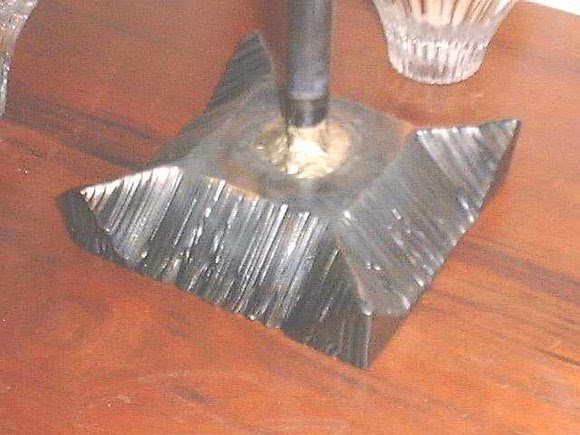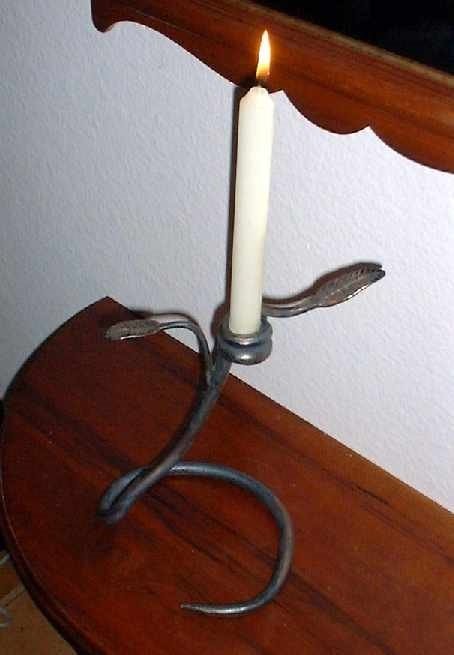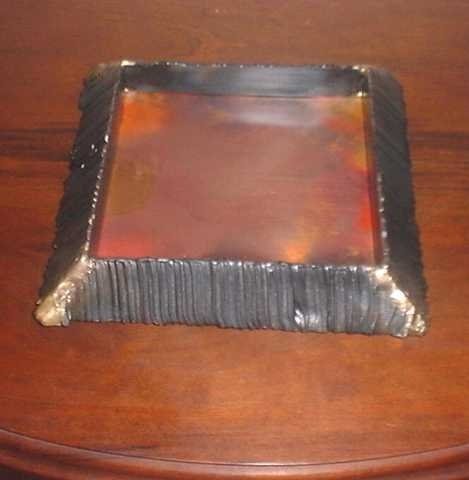Custom latch for a wooden garden gate designed by the homeowner. Forged from 1-1/2" x 3/8" mild steel to form an "H" using the cross-bar of the "H" as the latch. Each vertical member was 31" long before I started the scroll. Each "H" is about 18" tall and the cross bar was forged from 1" x 3/8" x 10" long bar. At this point all the hard work was done and I am bolting the the two H's together to determine the placement of the second latch for the inside of the gate. It worked out well too after it was installed.
Ready for the hot wax. After setting the rivets on one set of H's, I lightly wire brushed with a cup brush and applied a copper patina on the highlights. The long rivets I made from 1/2" round bar (with 3/8" tenons) are long enough to pass thru the 2" x 6" frame of the gate plus one inch on each side for the spacers. The hot wax is a mixture of equal parts of Bees wax, Paste wax and Linseed Oil. I melted the wax and applied it to the hot iron - black heat so we don't flash the mixture.
Layout complete and holes drilled for the latch. 1" spacers are made from 3/4" black pipe with a flat washer tack welded to each end so not to dig into the wood. The 1" makes it easier to grasp the latch and it makes for some nice shadows under the latch.
Finished! All the hard work really seems worth it now. I'm wishing I had an "H" in my name...
Close up shot. The flared ends at the bottom were probably the hardest part as they were formed by repeated upsetting and forging to get the flare while keeping most of the 3/8" thickness of the piece. Once I had the flare the rest was forged out to a 3/8" point over the 31" of length using George Craig's Little Giant power hammer. Thanks George!
Better view how the latch stands off the gate on the 1" spacers. Once the front "H" was pushed thru the holes in the gate, the "H" on the opposite side was slid over the tenons and was riveted in place using a torch and a sledgehammer as a backup.
~
Napkin Rings
Taken from Sue Murray’s dazzling design (which I was lucky enough to obtain at last year’s Balcones Auction), I executed this set of napkin rings using 1/4" cold rolled square stock trying to reproduce the reverse twist look that Sue was able to achieve in her design that used 3/16” stock. Once the piece was forged and twisted, I wrapped it around a chunk of axle that was about 1 7/8” in diameter. The ring was cleaned on the bench grinder with a wire wheel and then buffed with a hard cotton wheel using white polishing compound (thanks Jerry!).
I also made a few sets up out of 3/16” stainless steel (type 304) just to see how they would look. The ring on the left is the same as the ones above, made from 1/4" cold rolled steel while the one on the right is made from 3/16” stainless. The differences in feel and coloring are subtle but the main difference is that although the one on the right is only a 1/16 of an inch smaller in the square, it makes a for a much more delicate looking ring. Plus the stainless steel version has the added benefit of being able to go through the dishwasher without rusting in case someone gets a bit careless at the table.
For those interested in forging SS 304, it is a tougher material to work, and is very easy to get a flat spot in the scrolls while forming – you need to keep it red, no forging at a black heat on this material or you will not only get flat spots but splitting at the end of your taper, just like in mild steel. You don’t get the typical scaling that occurs on mild steel but you do get a nice dark gray oxide that forms on the surface that is very smooth and requires little or no wire brushing. I did finish the stainless rings with some pretty hard buffing on a cotton wheel using the same white jeweler’s rouge that I used for the 1/4" rings. The photos don’t show it well, but the corners of the twists have a nice polished edge that shows nicely against the dark, burnished look of the ring.
~
Candlestick Holders
Twisted 2 arm candlestick
This is a slightly modified design I found in one of the books in our Balcones Forge library, Elementary Wrought Iron by J.W. Bollinger. The book is reprinted by Lindsay Publications and has some great examples of projects for the beginning Smith. This one is on page 110. The upright is forged out of two 3/8 x 3/8 x 12" mild steel bars, the candle cups out of 3/4" black pipe and the base out of 10 ga sheet metal 5" in diameter. The book called for candle cups turned on a lathe and were screwed on. Instead, I opted for forged cups which were necked down with a piece of 3/8 bar inside the pipe so that they would slip over the arm of the stand. This one was done with a lot of help from George Craig, thanks George!Brazed Mild Steel Candelabra with Copper cup holders
View of the Candelabra base - 1" plate, flame cut edges
My first forge weld - Vine Candlestick Holder - 1/2" mild steel
Pair of forged Candlestick holders - 1/2" x 2" x 7" mild steel bar (each)
Pair of forged candlestick holders made from 1/2" x 2" x 10" flat bar - This one took lots of hammering as I don't have a power hammer yet.
4" square candle, ashtray or key/coin holder. Torch cut 3/4" sq bar on 45 degree angle mitered to form a square with copper bottom. Joints and copper bottom brazed in place.
Candle holder made from 3/8" rod forged to taper at each end with a leaf wrapping around a candle cup. Candle cup with round finial was forged out of 3/4" black pipe fullered down on a guillotine fuller at the anvil.
Candle holder made from 3/8" rebar forged to taper at each end with a leaf wrapping around a candle cup. Candle cup with round finial was forged out of 3/4" black pipe fullered down on a guillotine fuller at the anvil. Power brushed to bright finish and a copper patina was applied. I didn't like it so I put it back in the fire and went back to basic black with copper highlights which toned it down quite a bit. Sorry I don't have picture of the black version yet.
~
Hooks
Heart Hooks forged and split out of 1/4" x 3/4" mild steel flat bar. Hooks vary from 10 to 12 inches long and about 7" wide. Probably done the hard way, but it was fun.
Key chain fob with leaf motif forged from 3/8" sq cold rolled steel. I made half a dozen of these which wound up as gifts. I barely got a picture of this one!
~
My New Gas Forge
My new 3 burner gas forge built at the HABA Gas Forge Workshop. The only welding I had to do was for the burner tubes on the top and the legs. It's an oval design and is roughly 12" x 16" in the oval and 24" long. I can turn each burner on independently and it has an idler circuit built in to put the whole works on "simmer" if I want to conserve gas in between heats. It will run on a single burner on about 1/2 lb of propane when idling.
New forge in action. The removable ends lets me put wider scrolls inside or just use the mousehole as shown here
























